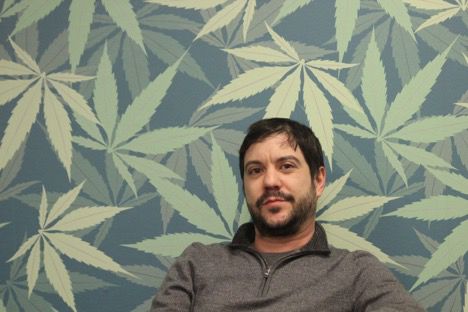Medical marijuana is finally available in Ohio. What does that mean for Kent State?
February 3, 2019
Ohio passed its medical marijuana law, House Bill 523, under former Ohio Gov. John Kasich in 2016, but patients were able to get prescriptions filled for the first time on Jan. 16.
The law allows patients who are over the age of 21 to have access to medical marijuana, which can be obtained at dispensaries throughout the state.
There are currently four dispensaries open in Ohio — none in the immediate Kent area — where people can purchase marijuana, one in Canton, one in Sandusky and two in Wintersville.There are plans for 60 dispensaries to open throughout Ohio in the future.
Kent State’s policy on medical marijuana
Although marijuana is legalized for medical purposes throughout the state of Ohio, qualified patients who are also college students cannot bring any amount of marijuana onto their respective campuses, including Kent State’s Kent campus and regional campuses. This is a result of the current Drug-Free Schools and Communities Act, drug policies that public universities are required to comply with to receive federal funding.
Todd Kamenash, the assistant dean of students and director of the Office of Student Conduct at Kent State, said the university finds itself in a difficult position.
“So, we can’t recognize medical marijuana here because federally, it is still considered a controlled substance,” Kamenash said. “Even though our state is more progressive about allowing it for certain purposes, we can’t do that because of the federal funding we receive.”
The “use, possession, sale, or distribution of narcotics, controlled substances and/or related paraphernalia” is prohibited, according to the university’s standards of conduct. This code, along with the current federal standing, puts the university in a difficult situation where students who are abiding to Ohio law will not be allowed to possess any medical cannabis on school grounds due to federal laws.
The university looks for guidance in the Association for Student Conduct Administration. The association includes universities from Oregon, California and Colorado — states that have authorized the use of marijuana for both medical and recreational purposes. Some of these other universities are facing the same issue as Kent State; since they receive funding from the federal government, they are unable to allow the use of marijuana, in any form, on their campuses. Many administrators are frustrated with the situation.
“It’s tough because we think ourselves as educators and we’re beholden to the times that we are in,” Kamenash said. “This is a situation where we can see that we are on the cusp of being behind the times, but we are limited in how we can address it.”
Am I eligible for medical marijuana?
For patients to be recognized as eligible recipients, they must qualify for one or more of the 21 conditions approved by the State Medical Board of Ohio, according to Ohio Marijuana Card, a business that helps individuals undergo the process of obtaining a medical marijuana card. The qualified conditions include chronic pain, cancer and Alzheimer’s disease.
Under current Ohio law, individuals who are interested in using marijuana for medical treatment are required to obtain a medical marijuana card, which grants them access to a range of products available in the form of edibles, tinctures, topicals and vaporizers. Ohio law does not allow patients to consume cannabis through any method that involves combustion, so patients don’t smoke or grow cannabis in their homes.
What are all of these?
Edibles, tinctures, topicals and vaporizers:
Edibles
-
Ingesting cannabis through edibles is a smoke-free alternative that Ohio dispensaries will offer its patients. Edibles are created by combining tetrahydrocannabinol (THC) with foods like chocolates, brownies and cookies. Edibles take longer to produce an effect, according to the Centers for Disease Control and Prevention. Sometimes, people consume more to feel effects faster, which can lead to anxiety, paranoia or other negative effects.
Tinctures
-
Tinctures are cannabis extracts, typically alcohol-based, that provide a smoke-free method of cannabis consumption for users, according to MassRoots. Tinctures are created by extracting a cannabinoid, one of the several chemical compounds derived from cannabis, from the dry flower and absorbing it into high-proof alcohol.
Topicals
-
Topicals are “cannabis-infused lotions, balms, and oils that are absorbed through the skin for localized relief of pain, soreness, and inflammation,” according to Leafly. This method is preferred by patients who want the therapeutic benefits of marijuana but wish to avoid the intoxicating, euphoric effects that other methods may produce.
Vaporizers
- Patients can also vape any medical cannabis they purchase. Vaporizers are an effective method of consumption, as the vape cartridge slowly heats the cannabis dry flowers and allows the user to experience the effects without smoking. All forms of smoking cannabis are prohibited under Ohio law.
In order for patients to be approved, they must be evaluated by a state-certified medical marijuana doctor, provide medical records that document their qualifying conditions and pay an annual registration fee to the State of Ohio Board of Pharmacy. Once this is completed, individuals who are deemed eligible will have access to the online patient registry, where they can then print off their official Ohio medical marijuana card.
The topic of medical marijuana has grown in popularity over the last five years, as 10 states and Washington, D.C., have passed legislation that makes recreational use of marijuana legal for adults over 21, providing cannabis advocates with state-by-state victories in the process. According to Business Insider, 33 states have legalized medical cannabis, and the number has steadily grown since the 2016 presidential elections. You can view all states that have legalized marijuana here.
Jake Richardson, the lead marketing manager at Ohio Marijuana Card, believes Ohio has been slow to implement a comprehensive medical marijuana program because cannabis is currently listed as a Schedule 1 drug under federal law, placing it in the same category as bath salts, heroin and LSD. All substances listed under Schedule 1 have a high potential for abuse and no accepted medical treatment in the United States.
The idea that cannabis is still listed as Schedule 1 drug confuses some of the people interested in exploring Ohio’s program, Richardson said. This is forcing many states that have legalized recreational and/or medical cannabis to struggle with this question: do law enforcement prosecute individuals who are legally permitted to use medical marijuana, according to their respective state laws, since it is still illegal federally?
“As far as Ohio goes, medical cannabis is legal but there is a disparity that federally it is still a Schedule 1 drug, so it is in the same boat as heroin, cocaine, PCP and acid,” Richardson said. “If there are so many doctors that have validated and accepted it as medicine, it is a paradigm shift that needs to happen at the highest levels of government because without it you are still going to have these disparities.”
Richardson believes as more states continue to legalize cannabis, people will become more aware of its therapeutic benefits, and this will allow for more funding in cannabis research.
He estimates that when he first started working at Ohio Marijuana Card, he would receive around 150 to 200 phone calls a day on average. He notes there has been a substantial influx of phone calls and in person meetings since the dispensaries first opened two weeks ago. The number of workers at the call center increased from four to 20 in order to accommodate the growing number of curious customers.
“99.9 percent of the people I talk to have terrible debilitating conditions,” Richardson said. “They are in pain, and their doctors are essentially holding them hostage by keeping them on painkillers. I want to get them the help they need. It makes me feel good at the end of the day to be able to help people get relief, know that it is helping them and turning them into advocates as well.”
How effective is medical marijuana, anyway?
While there are 21 approved conditions for patients to use medical marijuana, Richardson said chronic pain and post-traumatic stress disorder (PTSD) are the most common symptoms patients seek help for. Richardson said that many veterans have visited several Ohio Marijuana Card locations throughout Ohio to learn more about their qualifications and how medical cannabis may help alleviate their symptoms.
A growing number of studies reveal the therapeutic benefits medical cannabis may provide for individuals diagnosed with PTSD, a psychiatric disorder that can lead to the development of insomnia, chronic anxiety and reliving certain traumatic experiences. A study published by CNS Neuroscience & Therapeutics indicated synthetic cannabinoids can be an effective sleep aid for patients with PTSD struggling to control their nightmares.
It is a mixed bag though. Medical cannabis has also been linked with the possible development of substance use disorders in PTSD patients as well. According to a study published in the journal Clinical Psychology, people diagnosed with PTSD are two to four times more likely to struggle with addictive coping mechanisms compared to their peers who do not have PTSD.
Richardson said Cleveland and the state of Ohio are ready to welcome medical marijuana. Since Ohio Marijuana Card first opened in late 2017, interest in the company’s mission and the medical marijuana industry have steadily grown and are now peaking with the new law coming into effect.
“As it goes for Ohio, I think that the movement is just going to keep gaining steam, moving forward, Richardson said. “The stigma is going to be reduced even more, and we are going to keep trying to help as many patients to get relief as we can. That is the immediate and the long-term goals. We want to help people no matter what. We have helped thousands of people so far, and it feels good. It makes a difference, and it helps me sleep better at night.”
The future of cannabis at Kent State
Randy Davis, the current treasurer and former chapter leader of Students for a Sensible Drug Policy (SSDP), said he understands Kent State’s restricted stance on medical marijuana.
Davis has been a member of SSDP since 2016. During the spring of 2018, shortly after medical marijuana became legal in Ohio, the organization began to work with administrators at the university to find a way for medical marijuana patients, who are also students, to legally use it on campus. The university explained to the group that it isn’t able to do anything.
“They told us that they would just keep it blanket-banned on campus because it’s still against federal law, and they don’t want to lose money from grants and other federal funding, so that I understand,” Davis said.
But he still believes something needs to be done.
“I know that laws that are related to medical cannabis and the ailments that are eligible for patients are pretty severe,” Davis said. “So if the student were documented, there should be a way for use to take place in the legal form.”
Davis said he knows many students who qualify but cannot use marijuana to medicate on campus, and some are scared to face any penalties.
“There was one person who was afraid of getting kicked out of the residence halls, merely just for the possession of it,” Davis said. “Another one was simply scared of punishment from the university for doing something that is legally allowed by state law.”
When looking into medical marijuana it is important to understand the differences between Tetrahydrocannabinol, more widely known as “THC,” and Cannabidiol, or “CBD.” THC is known for its promotion of the euphoric effects commonly associated with the use of cannabis, according to LiveScience. We all possess cannabinoid receptors that are located in certain areas of our brains associated with memory, decision-making and pleasure. THC acts as an agent which activates our cannabinoid 1 receptor and causes the brain to release dopamine, providing the uplifting effects many users desire.
CBD is the other major compound derived from the cannabis plant. It is non-psychoactive, meaning it does not produce the mind-altering effects that THC does. Many patients are interested in CBD because it does not cause the user to get high, allowing the compound to successfully navigate through various political and legal hurdles so far. Numerous studies found evidence that suggests CBD can help treat and alleviate symptoms of epilepsy, schizophrenia, heart disease and other illnesses.
Kamenash said the federal medical marijuana codes and regulations may need to be adjusted as the local medical cannabis industry continues to develop in Ohio.
“It’s absolutely foreseeable that the federal government will start to take steps toward taking it off of the controlled substance schedule,” Kamenash said. “Some people in Congress have already begun those steps actually, but currently there’s not a whole lot the university can do because of the funding.”
Tyler Haughn is a general assignment reporter. Contact him at [email protected].
Chad Flannery is a contributor. Contact him at [email protected].















